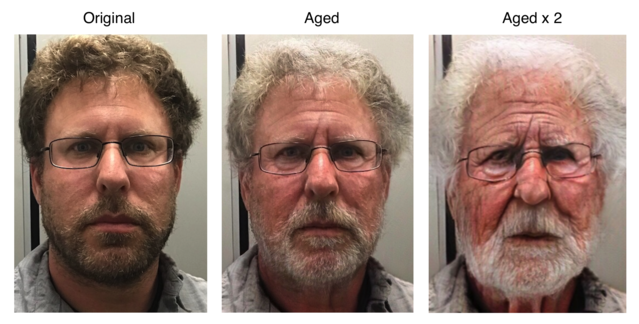Aging
Back to the Future
The allure and perils of seeing our future selves.
Posted July 31, 2019 Reviewed by Gary Drevitch
In Back to the Future, Part II, Doc Brown warns Marty McFly of the perils of running into one’s future self. He exclaims, “The consequences of that could be disastrous! […] the encounter could create a time paradox, the result of which could cause a chain reaction that would unravel the very fabric of the space-time continuum and destroy the entire universe! Granted, that's the worst-case scenario. The destruction might in fact be very localized, limited to merely our own galaxy.”
These perils notwithstanding, in the last few weeks, millions of people downloaded a mobile application called FaceApp and posted digitally altered versions of their faces on social media. The most popular alteration was the "aging" function, which produced striking images of what one might look like 20 or 30 years into the future. I must admit, despite the dire privacy concerns (uploading photos gives the Russian company behind the app perpetual access to your likeness), I used the app myself to see what I might look like over the next few decades:

Why did FaceApp go viral?
Face filters, like those available on Snapchat, have been around for years. People can beautify themselves, add doggy ears, get cool digital shades, or even FaceSwap with their friends. But unlike Snapchat filters, FaceApp does not simply add a “wrinkle filter” to your face. It does something more sophisticated, and produces much more compelling results.
FaceApp uses artificial intelligence (AI) to extract a 3-dimensional (3D) model of your face based on the image you upload. It then uses a proprietary algorithm to digitally “age” the 3D model, for example, by making the cheeks and nose sag, thinning out the lips, whitening the hair, and accentuating existing wrinkles to make the creases more noticeable. These digital alterations can appear so realistic, millions of users (including myself) willingly sold out our facial biometrics to create these brief digital glimpses into our future selves.
But why is it so compelling to see our future selves? And why are some people reluctant to do it? Research by Hal Hershfield and colleagues have demonstrated the potential impact of seeing and connecting to our older selves. In their experiments, participants immersed themselves in a virtual environment, where their avatar has been transformed to look like an older version of themselves, similar to FaceApp’s aging algorithm. After interacting with one’s aged avatar for a few minutes, Hershfield and colleagues found that participants’ saving behavior was altered: They reported being more willing to forgo immediate rewards and instead save more money for the future.
We still don’t know whether FaceApp users will experience similar behavioral changes after briefly seeing their digitally aged self – in fact, Hal Hershfield doesn’t think so. After all, Hersfhield and colleagues' experiments required interacting with the aged self and explicitly thinking about future behavior. Nevertheless, for some people, even a quick glimpse at digitally aged self can be psychologically intense. The effects, whether positive or negative, might depend on our current mood, and even on our current age. What might be fun for someone in their early twenties might be a scary preview of what’s to come for someone in their late sixties.
Whether we are drawn to look at our older selves or actively resist this, pretty soon we may not have much of a choice. As AI and deep learning continue to advance, digital facial transformations will become not only more available but also much more accurate. Currently, FaceApp's algorithm is based on a particular aging template, but not everyone ages the same way. Imagine how much more accurate the algorithm would be if it had access to multiple pictures of you, and pictures of you from 5, 10, or 20 years ago. Having detailed access to your facial past will dramatically improve the ability to predict your facial future.
Research by Megan Speer and Mauricio Delgado shows that when we reminisce about positive events in our past, we build a more positive view of ourselves, which can, in turn, enhance our mood. According to this research, selectively remembering past positive events (and ignoring past negative events) is a self-preserving psychological bias that can improve our self-concept. But this research, based on reflecting on the past, leaves open the question of what might happen when we mentally project into the future. What are the consequences of imagining positive or negative events in our own future? And does looking at hyper-realistic aged versions of ourselves automatically trigger these thoughts?
References
Hershfield, H. E., Goldstein, D. G., Sharpe, W. F., Fox, J., Yeykelis, L., Carstensen, L. L., & Bailenson, J. N. (2011). Increasing saving behavior through age-progressed renderings of the future self. Journal of Marketing Research, 48(SPL), S23-S37.
Speer, M. E., & Delgado, M. R. (2017). Reminiscing about positive memories buffers acute stress responses. Nature Human Behaviour, 1(5), 0093.


